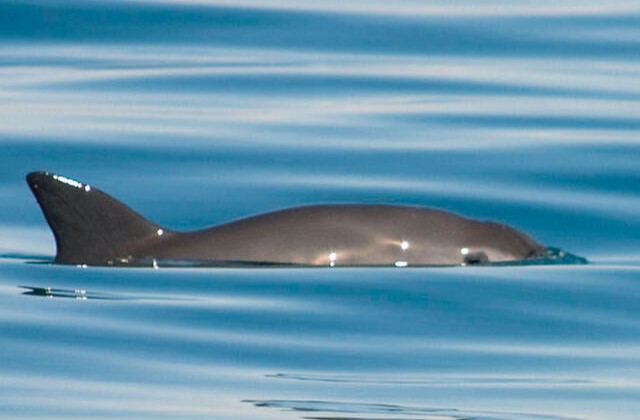The Vanishing Vaquita Marina: A Cry for Conservation

Vaquita marina in the wild (Source: Tom Jefferson, WWF)
In the vast expanse of our oceans, hidden beneath the surface of the Gulf of California, lies a tiny, enigmatic creature that you might not know about. The Vaquita Marina (“little marine cow”), is a captivating porpoise species. It has gained international attention for both its importance and alarming slide toward extinction. As someone with a passion for marine conservation, I developed an interest in the education and awareness of vaquitas. I could not believe such a charming creature was endemic to my own country. Yet its alarming population of 10 individuals left (survey by SSC), wasn’t being discussed with more urgency.
I will dive into the world of the vaquita, its endangered status, and human activities that threaten its very existence. I believe it’s imperative that we shed light on this critically endangered species. And take action to ensure its survival, not only for the vaquita itself but for the entire marine ecosystem.
Vaquita Marina’s Traits and Habitat
The vaquita marina, scientifically known as Phocoena sinus, is one of the smallest and rarest cetaceans in the world. These petite marine mammals measure just under 1.5 m in length and weigh around 120 pounds (World Wildlife Fund). Making them incredibly small compared to their cousins like dolphins and whales. They have distinctive dark rings around their eyes and lips, giving them a very peculiar and charming face.
Vaquitas are endemic to the northern Gulf of California. A unique ecosystem between the Baja California Peninsula and mainland Mexico (see map below). This area, characterized by a diverse range of marine life, serves as the vaquita’s primary habitat, and possibly their only one. They rise quickly to the surface to breathe, like other porpoise species, and their dorsal fin is often seen breaking the water’s surface.

Vaquita Marina’s range map (Source: Mark Garrison/Hakai Magazine)
Vaquita Endangered Status and Causes
The situation of the vaquita marina is nothing short of tragic. Despite their intriguing biology and ecological significance, these marine mammals are on the brink of extinction. They are critically endangered as of a few years ago. With an estimation of fewer than 10 individuals remaining in the wild.
The primary driver of their decline is entanglement in fishing gear, which is not even the target of fishermen. The main cause is particularly gillnets used in illegal fishing for the totoaba, a large fish prized with high commercial value. Vaquitas, unintentionally caught in these deadly nets, suffer a grim fate as their populations continue to plummet. Factors such as poverty, lack of alternative livelihoods, and the demand for totoaba swim bladders in illegal wildlife trade fuel the dangerous cycle that pushes vaquitas closer to extinction.
In addition to this, a lack of effective enforcement of conservation and penalties for illegal fishing has exacerbated the problem. In 1997 the vaquita population was 567 individuals. Then the incapacity for action led to a dropping population of 245 individuals by 2012. And then 97 vaquitas left in 2014 (La Vanguardia, 2021).
The protection plans enacted by the Mexican and U.S. governments continued to fail and the population continued to decline. In 2016 the number was reduced to 59. In 2017, it dropped to 30 individuals, then only 14 left in 2018. Reaching the tragic number of about 10 vaquitas remaining by 2019.

Example of a vaquita porpoise next to a fishing net (Source: UICN)
A Call to Action
The plight of the vaquita marina is a reminder of the devastating impact that human activities can have on marine ecosystems and species. However, it is not too late to make a difference. Numerous organizations, scientists, and conservationists are tirelessly working to save the vaquita from the brink of extinction. You can support the VaquitaCPR Conservation Program plan, adopt a Vaquita through the Porpoise Conservation Society or share this article with your network for more awareness.
The vaquita marina is not just a symbol of marine biodiversity, it is a testament to our responsibility as caretakes of the planet. Saving the vaquita is not only about preserving a single species but about safeguarding the health and balance of our oceans as a whole.
By supporting organizations dedicated to vaquita conservation and advocating for marine conservation in general, we can ensure that future generations will have the privilege of witnessing these magnificent creatures in their natural habitat one day.
Learn more…
If you want to know more, you can find the full 2021 Population Survey by UICN here or watch this interesting Last Vaquita Marina Guardians documentary by Reporte Indigo (in Spanish).
